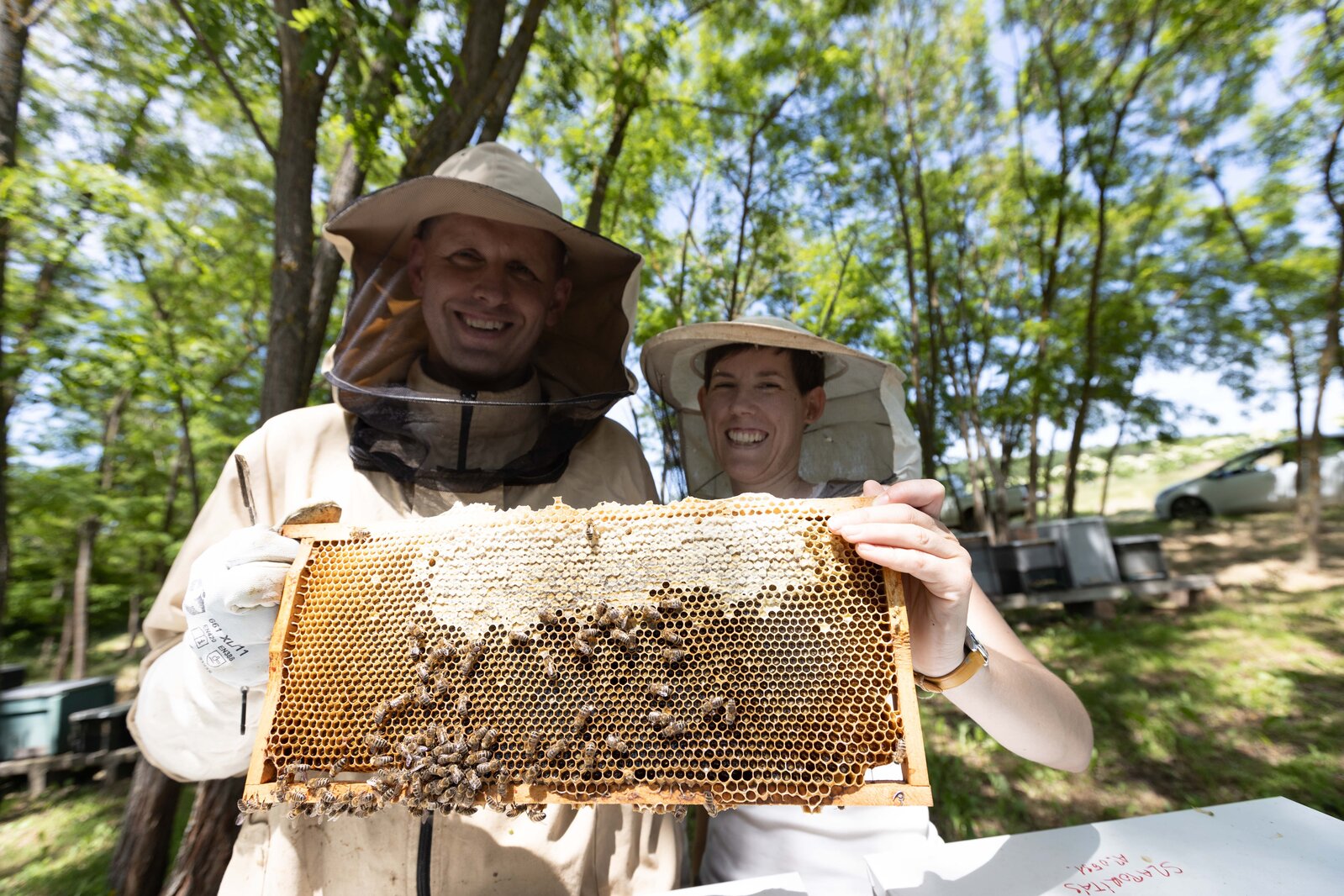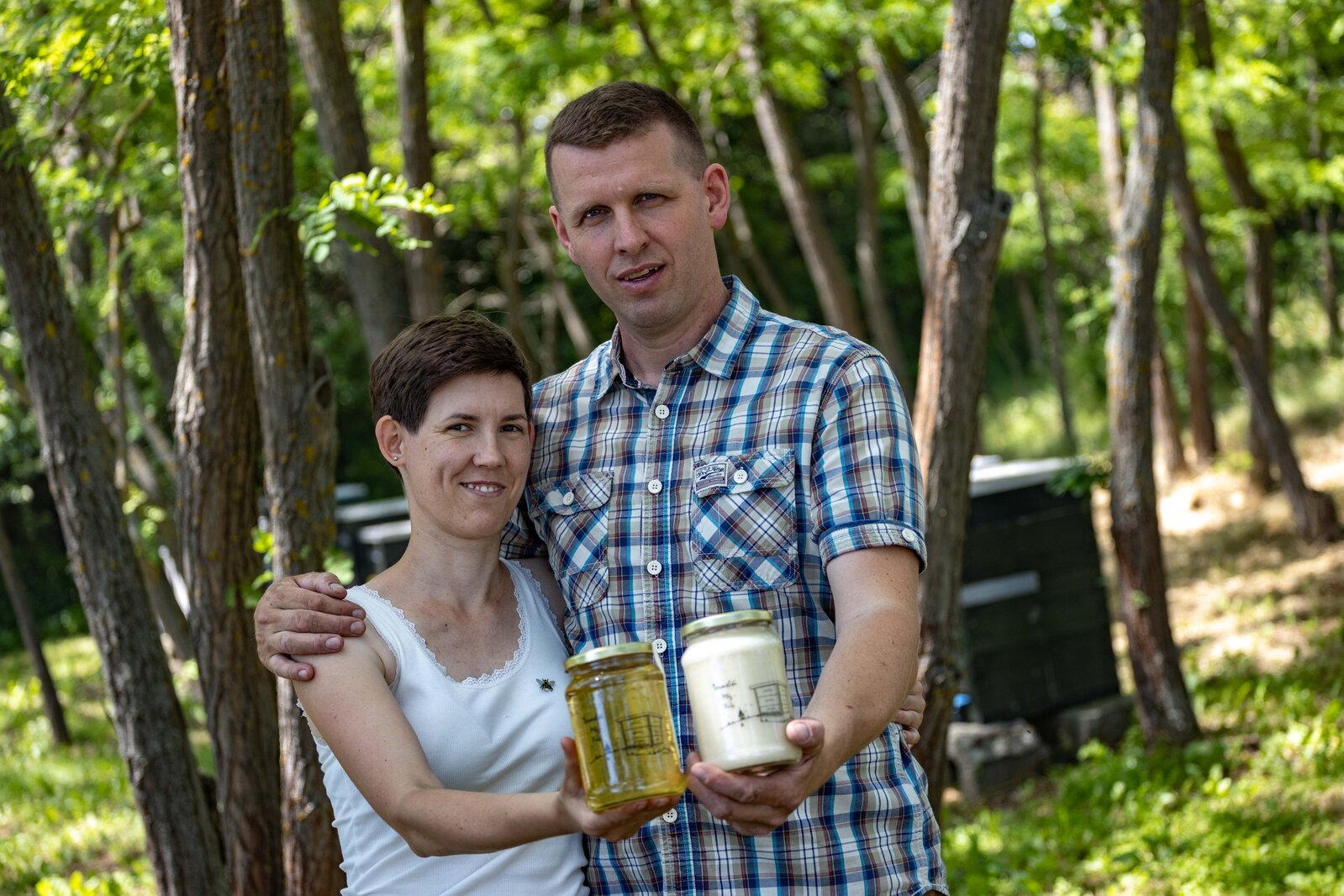Flavourful honey, straight from the hive – an interview with Zsófi Vers and Szilárd Puskás, the creator-owners of Pulai Méz (Pula Honey)
"It all started with a conversation ten years ago, when I went horseback riding with my friend Tamás...", Szilárd begins when I ask him where the idea of Pula Honey came from. They rode to an acacia forest, and he asked his friend why he didn’t keep bees there. The question upset his friend, whose uncle, a beekeeper, had been bugging him about this all the time. In the end, Szilárd met the uncle, the elderly beekeeper Jóska Mohos. He taught him the basics and inspired him and Zsófi to start keeping bees.

A year later, Zsófi and Szilárd bought their first ten families, started breeding them and grew to love the process of beekeeping. They were even more satisfied when they began to see the results. And so, at the foot of the Bakony, the Pula Honey Apiary was born, and it is now an entirely family-run business.
Why is it called Pula Honey?
The answer is simple: they were both born in Pula, and their entire family comes from this small Veszprém County village. Although Lake Balaton was close, still the forest, the trees, Bakony and its hills were closer to their heart than the lake.
There used to be four beekeepers in the village, all four of them were foresters, and we assumed that the species of the plants in the forest they looked after were probably good for keeping bees. That's how we started
- says Szilárd, who graduated as a wildlife engineer and earned an apiarian diploma a few years ago from Szent István University in Gödöllő. Earlier, he worked in the automotive industry and simultaneously farmed his land.
He now works as a full-time beekeeper. Zsófi helps with all the beekeeping tasks while holding a part-time job as an accountant. Zsófi is responsible for the indoor chores; she filters the honey, fills the barrels, and bottles the final product.

How is the honey made?
The bees collect the high sugar content nectar from plants and insects that suck the sap from the plants. They add enzymes, mix them, and deposit them in the honeycombs. They evaporate the water by rapidly moving their wings, creating a 78-80% saturated sugar solution, the actual honey. The colour of the honey depends on several factors, the nectar collected, its mineral content and its pigmentation, which may come from pollen or antioxidants. For example, canola honey is almost white. Its consistency is determined by its fructose-to-glucose ratio: the glucose ratio is higher than fructose, and in about three days, the honey sets and gains a creamy texture.
Honey production starts when canola starts to blossom. Acacia comes next, then phacelia, lindens, and sunflower. These are the primary nectar-producing plants.
Ideally, these plants blossom in succession, so the most important thing is to be able to provide bees with a constant area to forage for nectar, which is why we need to migrate the hives. We always extract the honey from the crop in question to offer our customers high-quality monoflower honey. The first step in the process is called "escaping". The bees are lured from the honey drawers, called ‘supers’, to the bottom of the hive with an escape board. The next day, when the bees are out of the way, we take the ‘supers’ home and extract the honey in the spinning room using a spinner
- Zsófi explains the process.

Quality products
Zsófi and Szilárd believe that only healthy and energetic hives produce good quality honey, requiring a landscape with diverse and rich 'bee pastures' in harmony with nature. They currently offer five to six types of honey: canola, acacia, spring flower, linden, sunflower and phacelia. It all depends on where they migrate their hives and bees and how much crop they can collect.

Don't be afraid of bees
As parents of two young children, Zsófi and her husband think it is essential for parents to start educating children about bees at a very young age.
When my daughter was in kindergarten, we took honey and bees to the kindergarten as part of the 'Honey Breakfast Programme' organised by the Beekeepers' Association to pass the love of bees on to the children. I have been to similar events in several places this year, and fortunately, more and more people recognise that there is a real need to explain to children that they should not be afraid of and should not squash the bees. I usually bring a small glass hive with bees and different tools for demonstration and have them taste different kinds of honey.

Will bees become extinct?
Albert Einstein is reported to have said, "If the bee disappears from the surface of the Earth, man would have no more than four years left to live". Asked how real the threat is, Szilárd says there is a real risk of the collapse of colonies, but it is usually caused by a disease.
We don't know exactly why they die, but fortunately, we can reproduce them quickly and repopulate within a year. It's sad and a big loss financially for the beekeeper if bee mortality is high because it makes a difference how many bees will produce honey the following year
he explains.

Sunny weather, happy bees
Our visit to the apiary also revealed that the weather affects not only people's moods but also the bees. When it's nice and sunny, the bees keep busy, and the beekeeper can work among them without a care in the world, but when it's rainy and overcast, the bees become nervous. The best time is when acacia is in flower, and it's nice outside because acacia provides so much nectar that it keeps the bees very busy. Should it be necessary, the bees can be placated with smoke.
It is evident from every word and gesture that Zsófi and Szilárd have found their life's calling in beekeeping. It is something they hope their children will carry on one day. The opening quote on their website further proves that they have chosen the right path. It says:
If you want to be happy for three hours, drink wine. If you want to be happy for three years, get married. If you want to be happy for a lifetime, build a garden and keep bees.

Did you know?
The Pulai Honey Apiary has also produced dedicated honeys for the VEB2023 EKF team.
